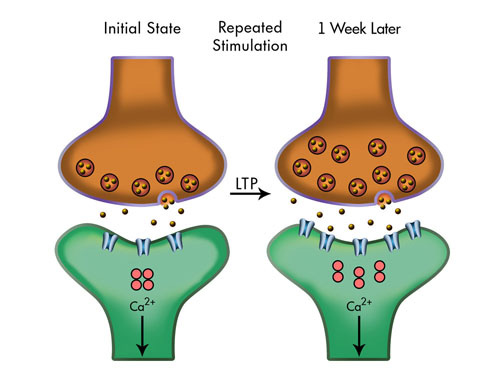Mechanisms of Plasticity
 Plasticity can occur through processes that take time, known as slow-onset changes, or through quicker process, known as fast-onset changes. Slow-onset changes are the anatomic changes of the neurons, including axonal growth, dendritic sprouting and neurogenesis--growing completely new structures, while fast onset changes are the activities that occur at the synaptic level. These kinds of fast-onset changes are known as synaptic modulation, which really means the ongoing process of strengthening or weakening of existing synapses. This process can be thought of much like the operation of your car, with the gas pedal representing excitation of synapses and the brake representing inhibition of synaptic responses. Thus, you really have two ways to make the brain go faster: strengthening synaptic connections through excitation (gas) and inhibition of other synaptic connections (brake). Persistent strengthening of synaptic connections through excitation (putting on the gas) develops long-term potentiation (LTP), or increasing the potential for that response to occur, while persistent weakening of other connections (putting on the brake) produces long-term depression (LTD) of a synaptic response.
Plasticity can occur through processes that take time, known as slow-onset changes, or through quicker process, known as fast-onset changes. Slow-onset changes are the anatomic changes of the neurons, including axonal growth, dendritic sprouting and neurogenesis--growing completely new structures, while fast onset changes are the activities that occur at the synaptic level. These kinds of fast-onset changes are known as synaptic modulation, which really means the ongoing process of strengthening or weakening of existing synapses. This process can be thought of much like the operation of your car, with the gas pedal representing excitation of synapses and the brake representing inhibition of synaptic responses. Thus, you really have two ways to make the brain go faster: strengthening synaptic connections through excitation (gas) and inhibition of other synaptic connections (brake). Persistent strengthening of synaptic connections through excitation (putting on the gas) develops long-term potentiation (LTP), or increasing the potential for that response to occur, while persistent weakening of other connections (putting on the brake) produces long-term depression (LTD) of a synaptic response.
< How Neuroplasticity Works Last | Next Synaptogenesis >

